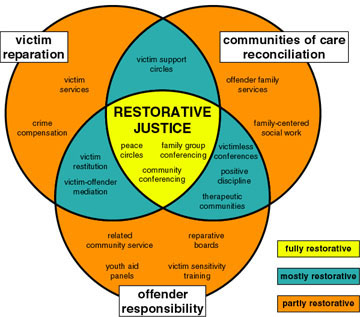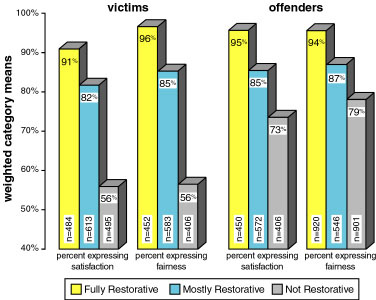By Paul McCold and Ted Wachtel. Executive summary of paper presented at the Fourth International Conference on Restorative Justice for Juveniles, Tübingen, Germany, October 1-4, 2000.
FINDINGS PRESENTED AT RESTORATIVE
JUSTICE CONFERENCE IN GERMANY
Paul McCold, director of research, and Ted Wachtel, president, of the International Institute for Restorative Practices, presented a paper entitled “Restorative Justice Theory Validation” at the Fourth International Conference on Restorative Justice for Juveniles, Tübingen, Germany, October 1-4, 2000.
The paper provides evidence that processes involving all stakeholders—victims, offenders and their family and friends—in responding to an offense, like conferencing, are more restorative than processes involving fewer stakeholders. The executive summary of the paper follows:
Restorative justice is a process involving the direct stakeholders in determining how best to repair the harm of offending behavior. As part of an effort to develop a theory of restorative justice, McCold and Wachtel propose a Restorative Practices Typology based on three direct stakeholder groups: victims, offenders and their communities of care. The degree to which all three are involved in meaningful emotional exchange and decision-making is the degree to which any program can be termed fully restorative. These three sets of direct stakeholders are represented by the three overlapping circles in Figure A. The Restorative Practices Typology asserts that outcomes from partly, mostly and fully restorative practices should be progressively better, on average, in an ascending order, as they become more restorative, and that all restorative practices should produce better outcomes than non-restorative practices.

Figure A
Types and Degrees of Restorative Justice Practice
To test the validity of the typology, data were collected from 13 published program evaluation studies where victims and offenders were surveyed. The restorativeness of programs was measured by percent of victims and offenders expressing satisfaction and fairness with their case. Results are from 14 conferencing samples (fully restorative programs), 15 mediation programs (mostly restorative) and 17 comparison samples (non-restorative). No participant surveys were available from partly restorative programs.
The overall results of victim and offender sense of satisfaction and fairness are shown in Figure B. Fully restorative programs are rated as more satisfying and fair for both victims and offenders than other categories of practice. Overall, offenders rated non-restorative programs as more fair and satisfying than did crime victims. Among the non-restorative samples, victims were less likely than offenders to feel satisfied and treated fairly.

Figure B
Victim and Offender Satisfaction and Fairness by Weighted Category Means
These results support the validity of the typology—that victim satisfaction, offender sense of fairness and the parity of outcomes are more restorative, on average, for fully restorative programs (conferences) than for mostly restorative programs (victim-offender mediation) and that both conferencing and victim-offender mediation are better than the non-restorative justice system. One should always try to involve victims, offenders and their communities of care in responses to crime. Those restorative practices which include all direct stakeholders, such as conferences and circles, should constitute the bull’s-eye on the restorative justice target.

